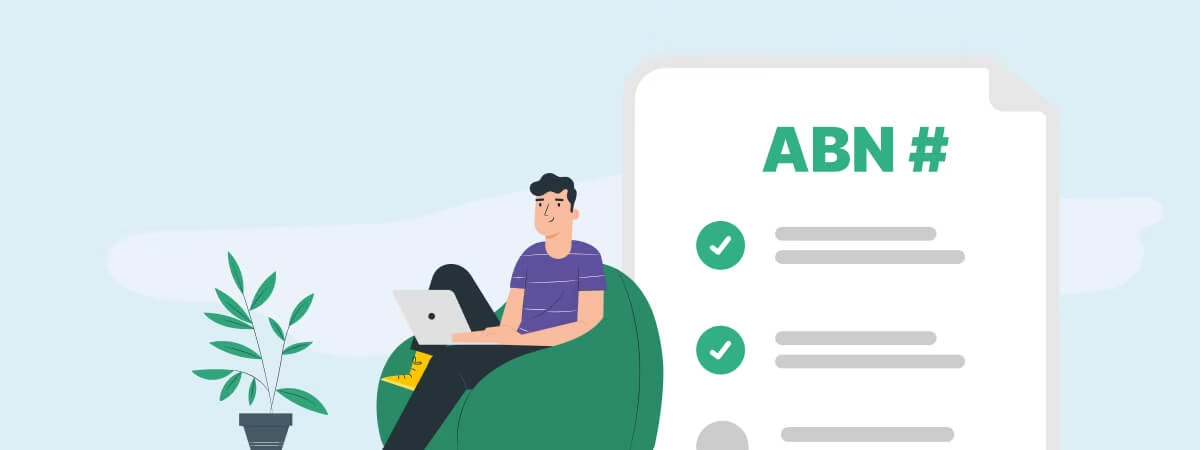Ready to become a sole trader and launch your own business? Fantastic! But before you dive in, there are a few things you’ll need to know.
Whether you’re aiming to become a freelance graphic designer, start contracting with government agencies, or sell bespoke chopsticks at your local farmer’s market, you’ll first need to get a few things straight. Like making sure you have a good market fit for your products/services, registering for an Australian Business Number (ABN) and (of course) figuring out what you’ll owe to the ATO.
You’ll also need to choose the right structure for your business: Do you become a sole trader or register as a private limited company?
Got questions? No worries! We’ve got answers. Let’s get you prepped for the exciting journey ahead!
What is a sole trader?
A sole trader is a trader who is… sole. This means you’re the one and only owner of your business. There aren’t any partners or corporate directors sharing the driving seat – it’s all on you.
This setup gives you the full say in the direction and decisions of your business. But don’t be fooled by the term ‘sole’, as it simply refers to your ownership status. You can be a sole trader and have employees or contractors who work for you, although many sole traders don’t.

Sole traders vs. companies: Which structure should you use?
When you’re kicking off your self-employed life, deciding whether to fly solo as a sole trader or set up a company is one of the earliest decisions you need to make.
Many independent contractors and freelancers opt for a company structure (a private limited company known as a ‘Pty Ltd’), but going this route is often unnecessary and can create extra complexity and headaches.Let’s get into the nitty-gritty of the company setup, and sort the facts from some of the myths that are floating around self-employed circles.
Pros and cons of registering a Pty Ltd company
Pros
- (Potentially) less liability. There’s a common belief that forming a company shields you from liability. While this can be true in some cases, it’s not a blanket protection. Directors are not automatically protected, and can face personal liability for the company’s debts, particularly for employees’ super, even if the company is deregistered or becomes insolvent. You’ll be personally responsible for as much debt as you take on, particularly if you take out a business loan or put your home up as collateral, and are the sole shareholder of the company.
- Access to funding from banks may be smoother. Banks are often prepared to lend more readily to incorporated businesses, especially for substantial capital or equipment expenses.
- It’s easier to sell portions of the business. If you want to bring in investors, more shareholders, or partners down the line, a company structure makes this easier.
Cons
- The company’s money is not yours. As a separate legal entity the money that the company makes is the company’s - and you can’t just dip into it as you like. Even as a sole director and shareholder, you still need to go through (potentially) complex methods to pay yourself, and the income you earn is still taxable in your own name whether it’s received as a salary or dividend.
- More complicated tax matters. The main way to get money out of a company is to pay yourself a salary, which is taxed at your individual tax rate. But you also have to pay tax on the company’s profits. From 2024 onwards, the company tax rate is 25%. This means you’re essentially sorting tax and compliance for two separate entities: yourself and your business. It’s a whole lot more complicated than just doing your own taxes.
- More expensive set-up and operating expenses. Setting up a company can be expensive. Think registration fees, annual lodgements, and compliance costs associated with things like dedicated business banking. All this to support a business structure you may not need.
- Complicated accounts. You’ll likely need to hire a bookkeeper and an accountant to ensure you’re keeping meticulous records in case the ATO decides to audit you, and to ensure you’re compliant with the Company’s regulatory body ASIC (Australian Securities and Investments Commission).
Pros and cons of being an ABN Sole Trader
Pros
- Simple accounting. All the profits you make are yours – no need to pay yourself a salary out of company profits. Yay!
- Low set-up and operating costs. It’s easy to apply for an ABN as a sole trader, and it costs very little time and money to maintain that structure. From the get-go you save hundreds, possibly thousands, of dollars on government registration fees, lawyers, and accountants (Hnry has you covered on the latter!)
- Less tax and compliance admin. You only need to sort your own taxes, instead of lodging returns for both you and your company. Much simpler!
- All the benefits of trading as a company. You still get an ABN, can trade under a business name, and claim business expenses – without the hefty compliance costs associated with a company.
Cons
- Potentially higher liability. Your wallet is on the line if things go sideways with debts or other business problems. As there’s no separate legal entity for your business, like there is with a company, you may be held personally responsible for everything. While this can often be mitigated through insurance policies, it can be a worry for many sole traders.
- Access to funding can be limited. Banks may see you as more of a risk than a company. You’re also less likely to attract investors as a sole trader.
- You can’t co-own the business. Going solo means just that. If you want to bring in a partner or add other business owners, you’ll have to register a different business structure.
As you can see, each business model has its merits and downsides. If you’re planning to operate independently without seeking significant loans, hiring staff, or taking on partners, the sole trader route is generally more straightforward and beneficial.
📖 While this decision might feel a bit complicated, we’ve created a simple quiz to help you figure out what works for your business.
💡Note: This should not be taken as financial advice. Company taxes are complicated and nuanced based on your circumstances, what industry and size you are operating at. If you have concerns or questions, speak to an accountant to see what structure is best for you.

How to register as a sole trader
Apply for an Australian Business Number (ABN)
Setting yourself up as a sole trader is fairly uncomplicated, and best of all it’s typically free.
One of the first things to do is register for an ABN, a unique 11-digit number issued to all entities registered in the Australian Business Register (ABR).
If you expect to earn $75,000+ in self-employed income over the next 12 months, you’re required to have an ABN (and also register for and charge GST).
Earning less than $75,000? You can still apply for an ABN, and here’s why you might want to:
- It makes your business easily identifiable. This is particularly handy if there are other businesses with a similar name to yours, because while people may confuse your name, they’re unlikely to confuse your ABN.
- If you want to register your business name nationally (and make it unavailable to other businesses in Australia), you must have an ABN.
- Without an ABN, businesses paying for your products or services may be required to withhold and pay a significant part of your payment – up to a whopping 47% – to the ATO as income tax on your behalf. Eeep!
Securing an ABN paves the way for you to start earning independently, but it doesn’t restrict you from supplementing your income through employment (PAYG) or contracting work. Nor does it prevent you from operating under a business name.
Plus, with an ABN, tax time is more streamlined than operating a company, since you’ll only need to lodge one individual tax return, akin to a PAYG employee (more on that later).
How to apply for your ABN
To obtain your ABN as a sole trader, you’ll need to own and be fully responsible for all aspects of your business, including any debts. Don’t worry – you can still employ others, just not yourself.
You apply for your ABN on the Australian Business Register website, which is a breeze, provided you have all the necessary information to hand.
Here’s our tailored checklist for the ABN application process. Keep in mind, some of these may not apply to your situation:
- Your personal Tax File Number (TFN)
- If you use a tax or BAS agent, their official number (it’s cool if you fly solo without one, many sole traders do)
- Previously-held ABN if this isn’t your first time out of the gate
- The date you want your ABN – Aim for your business launch date, but don’t shoot more than six months ahead
- Your legal entity name – Many sole traders simply use their full name, but you can pick another name for your business
- Authorised contacts – List any contacts like a tax or BAS agent authorised to make updates on your behalf
- Your business’s contact details – address, postal address, email (keep it personal, not ‘info@’ style), and phone number
- Business description – Nail down what your business is all about and what it does
- Base of operations – You need to share a physical location for your business unless doing so would compromise the safety of people (eg if you operate out of a domestic violence refuge)
Pop in all your details, and if everything’s on point, you should receive your ABN immediately.
Sole trader taxes
As mentioned earlier, as a sole trader, you get the profits from your business and simply pay tax at the individual tax rate. You also get to claim business expenses as tax deductions – yay!
📖 Claiming eligible tax deductions can be tricky – the ATO are very specific about what they will and won’t accept. For more information, check out our guide to tax deductions for sole traders. Or, you can join Hnry, and we’ll manage your expenses for you.
You’ll need a tax file number (TFN), which you should already have if you were ever an employee. If you’ve never been an employee, you can apply for a TFN from the ATO website.
You’ll also need to start saving for things like:
- Income tax
- Medicare levy
- GST (when you start making over $75,000 in self-employed income)
- Student loan repayments (if applicable)
- Superannuation contributions (optional)
📖 For an estimate of how much to set aside, check out our sole trader tax calculator.
… or, you could use Hnry.
Hnry sorts your taxes for you
So there you have it – your guide to becoming a sole trader.
Remember though, you may be a sole trader, but you’re not on your own when it comes to your taxes. Hnry’s here, in your pocket, whenever you need us.
We’re an award-winning app for sole traders. We take care of all your tax needs – at a fraction of the cost of a regular accountant. No headaches, no stressing about numbers.
You also gain access to our app, which you can use to send unlimited quotes and invoices, quickly raise and manage expenses, and automate your savings/investments/donations. We’ll even (politely) chase up late-paying clients on your behalf, so you don’t have to.
Basically, we take care of the tax and admin stuff so you get to focus on what you do best: Running your business. Join Hnry today!
Share on:

